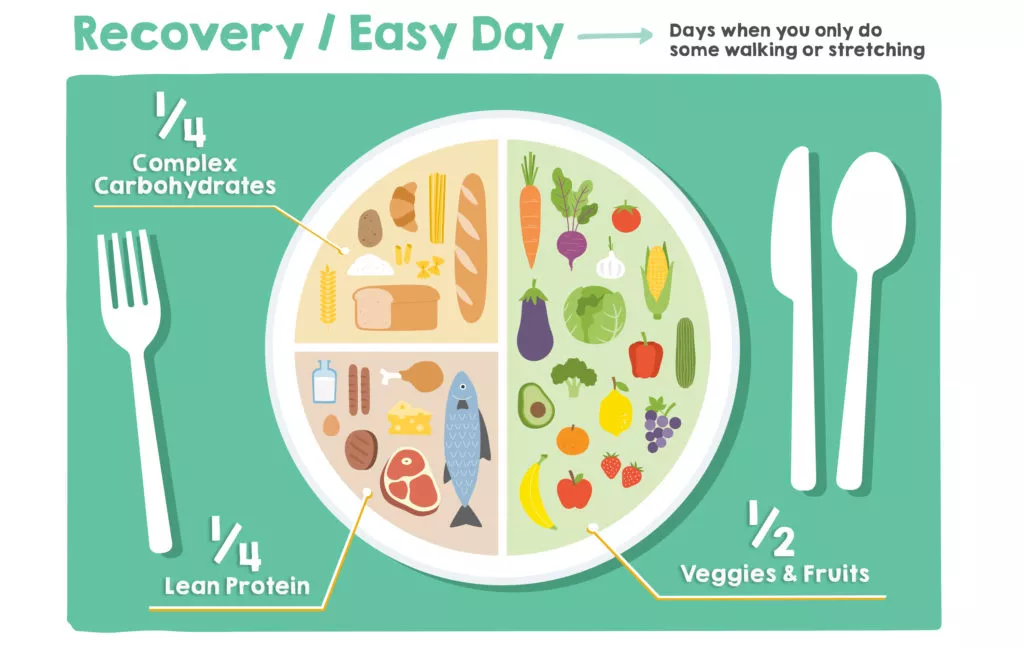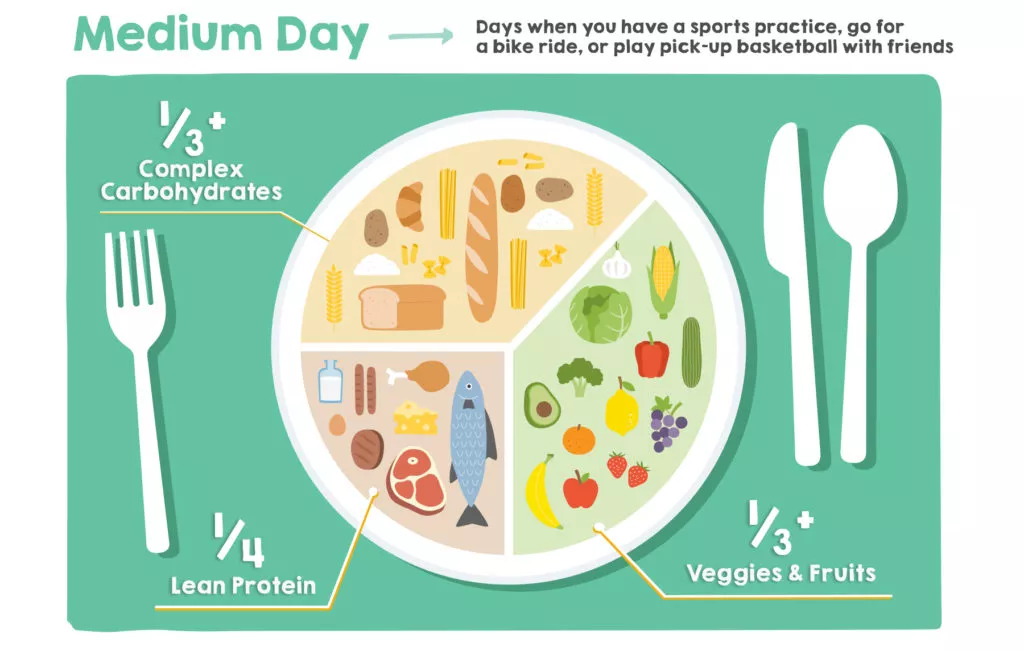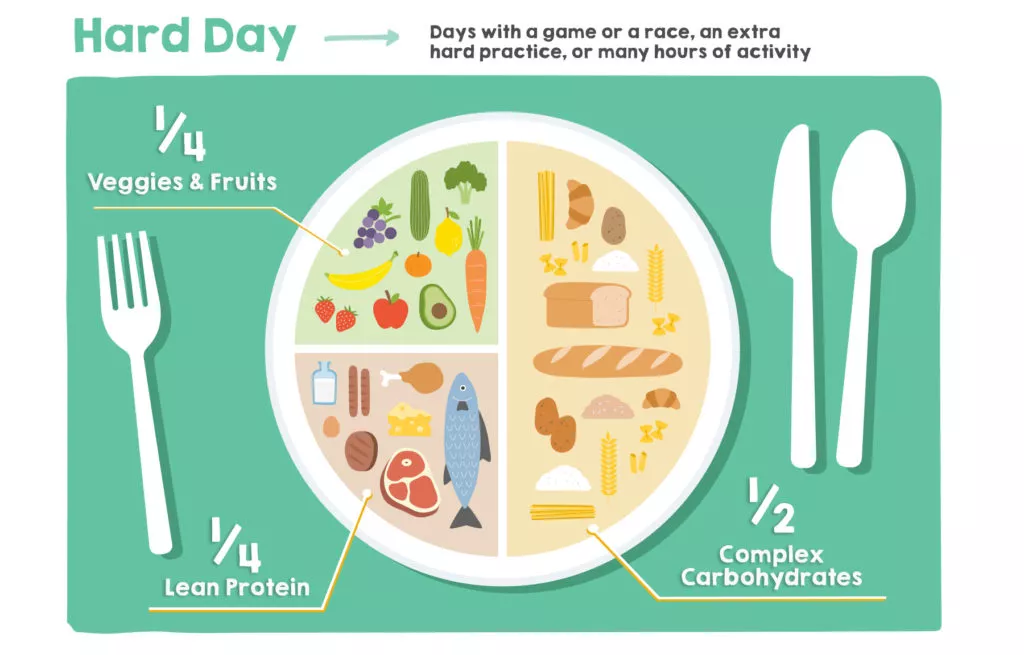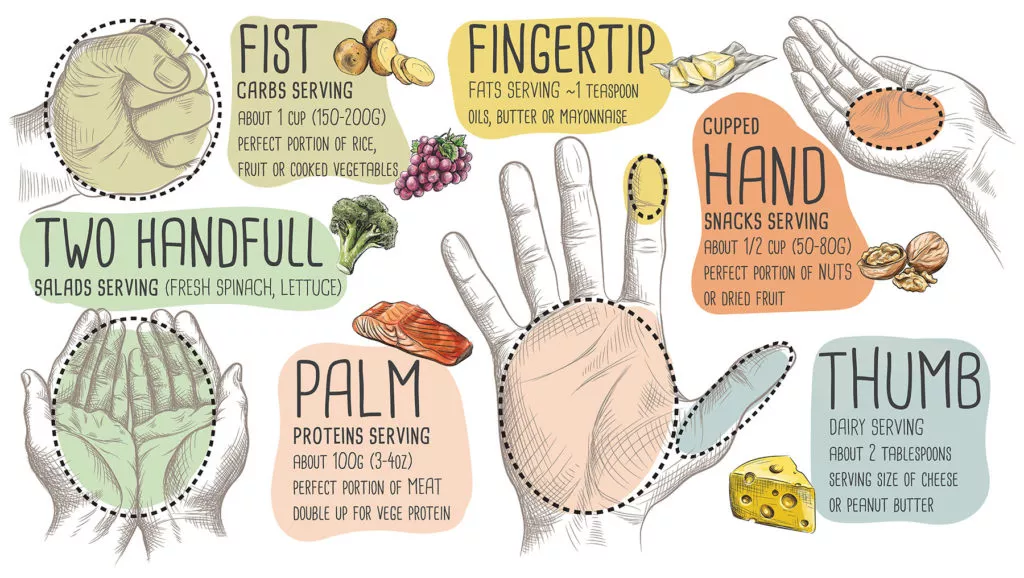You just walked in the door from an intense soccer practice and are headed straight to the kitchen. Your stomach is begging for food! How do you choose what and how much to eat? When we are really hungry, we often choose something out of a bag or a box that’s quick to prepare — pretzels, a bowl of cereal, a muffin. When we get hungry or tired, it is harder to make good choices and to take the time to do more complex meal prep. However, with a little knowledge and some planning ahead, you can start making smarter choices on when, what, and how much you eat.
Foods to Maximize
There are three nutritious categories of food that are important to have on your plate no matter what meal, snack, or time of day it is.
- Vegetables and Fruit (these are nourishing foods)
- Complex Carbohydrates (these are re/energizing foods)
- Lean Protein (these are building foods)
Foods to Minimize
There is a fourth category of food to avoid most of the time, although it is absolutely ok to indulge in a treat once in a while.
4. Empty Foods (these are foods that taste good but have little to no nutritional value)
Best Foods to Eat Per Category
Category #1: Veggies and Fruit (Nourishing Food)
- Dark leafy greens like Lettuce, Spinach, Kale
- Broccoli and Cauliflower
- Carrots
- Peppers
- Green beans or Snap Peas
- Cucumber
- Banana
- Apples
- Oranges or Grapefruit
- Peaches or Pears
- Watermelon
- Berries
Category #2: Complex Carbohydrates (Re/Energizing Food)
- Whole grain breads and pasta
- Rice, Quinoa, Oatmeal
- Potatoes and Sweet potatoes
- Beans and Lentils (also proteins)
- Higher-sugar fruits like banana, mangoes, and dried fruit
Category #3: Lean Protein (Building Food)
- Chicken and Turkey
- Fish
- Lean Beef
- Eggs
- Tofu
- Beans and Lentils (also complex carbs)
- Unsweetened Yogurt
- Protein Powder
Category #4: “Empty Food”
These are foods that taste good but doesn’t provide many health benefits.
- Soda
- White breads, pastas
- Sugary cereal
- Pastries, cakes, cookies, donuts
- Candy
- Fried foods
- Sugary coffee drinks and frappes
How Much Should I Eat?
One of the best things you can do to ensure you are eating well and getting the nutrients you need is to use your plate as a visual guide to balance your meals. For each meal, divide your plate into four quarters. Fill one quarter with your protein, another quarter with something starchy, and the final two quarters with vegetables and/or fruits. See some examples of each category below.
How much of each of the three nutritious categories is on your plate will depend on how active you are on a given day, and what you have planned in the near future.
Recovery/Easy Days:
Days when you only do some walking or stretching*
- Veggies and fruits = 1/2 of your plate
- Complex carbohydrates = 1/4 of your plate
- Lean protein = 1/4 of your plate
Medium Days:
Days when you have a sports practice, go for a bike ride, or play some pick-up basketball with friends
- Veggies and fruits =1/3+ of your plate
- Complex carbohydrates = 1/3+ of your plate
- Lean protein = 1/4 of your plate
Hard Days:
Days with a game or a race, an extra hard practice, or many hours of physical activity
- Veggies and fruits = 1/4 of your plate
- Complex carbohydrates = 1/2 of your plate
- Lean protein =1/4 of your plate
*When you serve yourself lunch or dinner, make sure the ratios on your plate reflect your activity for the day! The one exception to all of this is, for example, say you have an easy day today, but tomorrow you have 2 games to play. In this case, start getting your body fueled up ahead of time by eating as if it were a hard day!
Pro Tip for Athletes:
Preteen and teen athletes may feel pressure to diet or lose weight as certain sports like running, gymnastics, wrestling, and figure skating place a high emphasis on weight. It is important for young athletes to meet their energy needs as insufficient calories can inhibit growth and place them at a high risk for injury. Young athletes should follow the plate guidelines on a daily basis to ensure that they have the energy for training and are recovering in between sessions.
Young athletes also especially need to focus on getting adequate calcium and iron. Calcium from whole foods is important for building strong bones that are resistant to fractures. Iron from animal protein, leafy greens, and iron-fortified foods is essential for getting oxygen to your muscles: a process that you need for sports involving aerobic activities like running and swimming.
Game and race day eating:
Not only do preteen and teen athletes need to modify their plate ratios depending on their level of activity, they also may have special nutrition needs on game and race days.
- 3 to 4 hours before your game or race, eat a meal composed of mostly starchy carbohydrates like oatmeal or rice and protein, with minimal fat. Fat slows digestion and could lead to stomach issues.
- 1 to 3 hours before your game or race, eat a smaller snack or meal that contains easy-to-digest carbohydrates like a banana, rice cake, or crackers.
- After your game or race, eat some carbohydrates and protein within 30 minutes. This could be a protein smoothie or a premade bowl of rice and eggs. Then, eat a full, balanced meal within 2 hours after your game or race.
What is a serving size?
Now that you know how to divide up your plate, this will certainly help with knowing how much of each kind of food to eat. However, plates can be all different sizes, and the serving sizes listed on food labels are not necessarily telling you how much you should eat, so it is helpful to understand exactly what is a good serving size of each type of food.
The serving size listed on food nutrition labels provide information on how many calories and nutrients are contained in a specific amount of food. Those serving sizes may be more or less than what you need for your size, age, and activity level. It is a good idea to eat more than a serving size of vegetables — since you’re getting even more vitamins, minerals, and fiber. But be aware that eating multiple serving sizes of potato chips may lead to consuming more empty calories and fat than you need, resulting in potential weight gain and health problems.
Simple ways to estimate serving sizes
A simple way to estimate healthy serving sizes is to use your hand as a measuring device for each of the plate categories mentioned above.
Starches, vegetables, and fruits: Make a fist with your hand, that is about the size of 1 cup. 1 cup is the recommended serving size for your starches, vegetables, and fruits.
Protein: Any serving of meat or poultry should take up about the size of your palm.
Fat: Added fats like oil, butter, mayonnaise, and dressing should be limited to the size of the top of your thumb.
10 Tips to Eat the Right Amount of Food
- Eat your vegetables first: Eating your salad or other vegetables first — and simply eating more of these in general — will help you feel more full without consuming too many calories.
- Stay hydrated: Oftentimes thirst is confused for hunger. If you stay hydrated, you will more accurately be able to feel when you are hungry and full.
- Don’t eat in front of the TV or other screens: Mindless eating in front of the TV or computer can lead to overeating. Instead, really be present when you are eating; enjoy the taste and textures of your food and listen to your body so you know when you’ve had enough.
- Eat a well-balanced meal or snack at regular times during the day: Eating balanced meals and snacks every few hours will help keep your blood sugar stable and will help you avoid getting over hungry. Skipping meals or waiting too long to eat can lead to overeating at the next meal.
- Eat slowly and chew your food well: Taking your time while eating will allow your body time to signal when it is full.
- Beware of restaurant portions: Most restaurant portions are well over the recommended serving sizes outlined above! Sharing a meal, setting aside half to take home, or selecting the smaller of the portion options can help you eat the right amount when you are out to eat.
- Remove a serving size of food before you eat: Rather than eating out of the bag of crackers or jar of nut butter, try measuring out a serving size onto a plate and eating from that. You’re less likely to overeat if you measure out in advance.
- Use smaller plates or bowls: A cup of rice might look tiny on a large dinner plate, but it will look much more generous in a small bowl.
- Avoid jumbo and giant size “value” meals: Unless you are planning to split food with others, don’t opt for the super-sized meals just because it is a better value. Most likely it contains way more calories than you need!
- Listen to your body: The best way to know you are eating the right amount is to listen to your body’s hunger and fullness signals. This means you need to be in tune with your body and eat when your body tells you it needs fuel, and avoid eating when you’re simply bored or something looks or smells delicious. Stop when your body is satisfied. Don’t waste your leftovers — save them for later — but don’t force yourself to finish a meal simply because it’s on your plate.
6 Healthy Snack Ideas
To make good snack decisions easier, here are 6 healthy snack options to have ready in advance that contain the three nutritious food categories.
#1. Snap peas or pre-sliced veggies and hummus
#2. Fresh or frozen berries with yogurt
#3. Smoothie with protein powder, fruit, spinach, and your favorite milk (dairy or non-dairy/plant-based)
#4. Nut or seed butter on an apple/banana, or on celery with raisins
#5. Turkey slices on a brown rice cake with baby carrots
#6. String cheese with whole grain crackers and grapes










